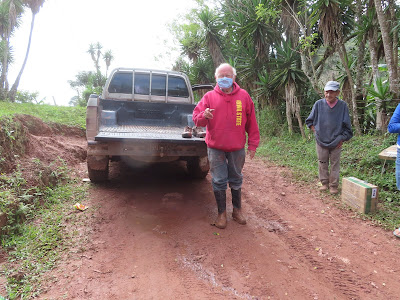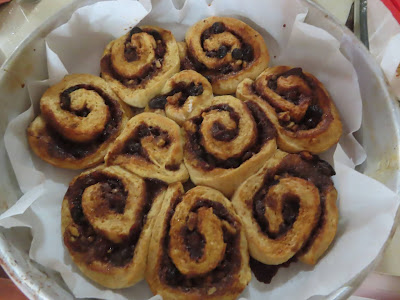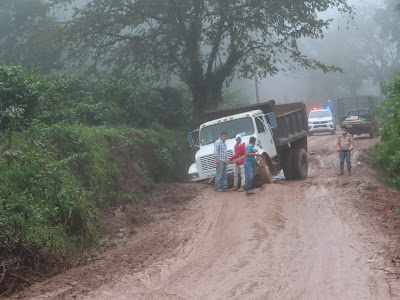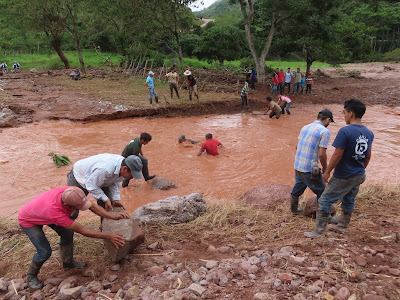I visited several rural communities to help evaluate what had happened and brought supplies for those affected by the hurricanes. The adventures included getting stuck in the mud on the way to Vertientes, in the road just below the white house in the center of the photo.
I helped transport workers to and from the parish coffee field.
I even hosted two young priest in my hone one day, where we worked on the themes for materials for base communities for next year.
One of the joys was baptizing eight children in a rural community. They insisted on having a group picture with me afterwards. Some had family members taking individual photos with me. But I noticed one boy, about 10 years old, who was there with an older woman as his sponsor. No one took a special photo of him and so I took a selfie which I’ll have to print and get to him.
One big surprise for me is that the parish got a new pick up which is for my use. After a visit to the US two years ago, someone sent an anonymous donation for a new parish vehicle. The hassles of bureaucracy and the pandemic delayed everything. We finally picked up the vehicle in San Pedro Sula on December 4. I am still trying to get used to it.
The mural in the apse of the parish church was also completed this month in time for the diaconal ordination of Fernando, a seminarian who has been with the parish since the beginning of the year. It is a marvel.
One frustration, among many, was waiting in line for six hours at the Registro de la Propiedad, thinking that they would have the license plates for the new parish truck. It seems that I have to get them from the local Toyota dealer. The Toyota dealer in San Pedro Sula didn’t say where to get them. I have to call Tuesday to see if the plates arrived in Santa Rosa (from the Toyota dealer in Tegucigalpa.)
 |
| Photo by Ana Chavez |
But Christmas time has also been filled with surprises.
I spent the morning of December 24 baking cinnamon rolls.
I had planned to go to the 9:00 pm Mass in Dulce Nombre and so had left time in the early evening to prepare, in case I had to preach.
But I got a call from the pastor, asking me to go to Santa Rosa to pick up a parishioner who had just been treated for a fall from a truck. I said yes, especially when I heard that it was Adolfo, a communion minister, who is indefatigable going around – on foot – to visit the sick. In fact, he fell while on the way to visit a woman who was seriously ill. He had fractured a rib but was not held overnight in the hospital.
I picked him up with a daughter of his and took him home to Vega Redonda.
It was about 8:30. I didn’t know if I’d get to the 9 pm Mass on time but decided to go to Dulce Nombre anyway.
I got there about 9:20 and Mass had just begun. I ended up entering the sanctuary during the Gloria. As the readings began, the pastor leaned over to ask me if I would preach. I said yes. Even though I didn’t feel fully prepared. I hope I was understandable.
After Mass I got home and got to bed at about midnight.
I had originally planned to go to Debajiados, but after talking with the delegate of the Word there I decided it might be better to postpone my visit, since the road out of the community was up a hill that was quite slippery with all the reins we’ve been having. Instead, I went to Vega Redonda.
It ended up being a fortuitous choice, since Adolfo, the communion minister there, wasn’t able to get to the celebration, but still they were able to receive Communion on Christmas day.
After the celebration, I left for La Entrada, Copán.
It’s been a tradition since I got here to spend Christmas with the Dubuque Franciscan sisters. There are now three here in the diocese – two in Gracias, Lempira, and one in La Entrada.
It was great to spend the time with them as well with another associate of their community who lives in Gracias, across the road from their house. The conversation was great, including a zoom with some Dubuque Franciscan sisters in the US, including a novice from Central America.
But what was a real highlight was the food, much more than we could eat. Even more delectable were the desserts, including a pecan pie. I left with a plate of cookies and lots of other treats. I left them with cinnamon rolls.
Saturday, the feast of Saint Stephen, patron of deacons, I went to San Agustín for a wedding. The pastor officiated but I wanted to be there because I knew both the bride and the groom. The bride has been a catechist for about eight years; the groom entered the church as a catechumen about three years ago. It was a joy to see them joined together in the sacrament of matrimony.
Sunday, I managed to get to Debajiados in the morning. Part of the road was slippery, but I managed to avoid going off the road. I led the Celebration of the Word with Communion and then spend a little time with the folks. I had brought bags of provisions for three families donated by some folks from Tegucigalpa, as well as a few blankets. I also brought a bag of candy. I learned of other needs – another family could use a bag of provisions and there are about six kids who could use some clothing. I’ll have to make another visit soon.
On the way back I stopped to take a photo of a place near Delicias where half of hte road had fallen in, due to the hurricanes. This is why I try to avoid driving at night!
I got back to Plan Grande where there was going to be a Mass in the afternoon, which would include the funeral of a man about sixty who had died yesterday. But the pastor has a delay and so I ended up presiding at the Celebration of the Word with Communion, as well as Commendation in the church. A delegate went to the cemetery.
Such is the life of this permanent deacon in rural Honduras, even in the wake of a pandemic and two hurricanes.
The next few days are not very busy – at least I think so. Though I spent this morning, Monday, with Fernando, the transitional deacon and three other people, distribution bags of provisions to people in Dulce Nombre and Caleras. I got to see parts of Dulce Nombre I didn't know existed.
 |
| In Caleras |
I have enough to do, evaluating some scholarship applications and preparing materials for base communities. I will also try to do a personal evaluation and plan for next year. There are also a few repairs on for the house I need to get arranged.
This has been a unique year for me and for Honduras – the pandemic, two hurricanes, and the continuing poverty, corruption, and inefficiency.
Who knows what next year will bring?
They are saying that the COVID-19 vaccines will arrive in the second quarter of 2021. We’ll see.
There is a real need to begin the rebuilding after the hurricanes; two problems I see are the danger of the politicization of the aid and the diversion of the aid for political purposes as well as for the bank accounts of corrupt politicians and their “friends.” 2021 is also the election year and who knows how that will work out.
But in the midst of this we keep trying to serve the people.
A major challenge will be rebuilding. Our parish will be trying to get people to work together for rebuilding, as well as the possible relocation of several communities.
But, as Hölderlin wrote (as quoted by Pope Francis), “Where the danger is, also grows the saving power.”





















































